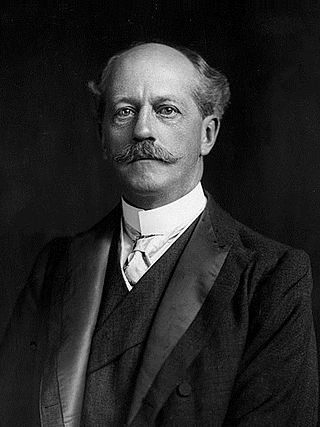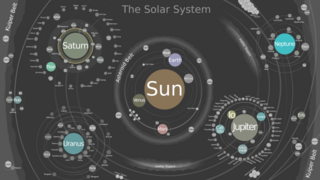Examples
- 1978 image of Pluto and Charon; the discovery image of Charon
- Discovery image of Saturn's moon S/2004 S 3
- Discovery image of active volcanism on Io
- Discovery image of Pallene
- Mariner crater on Mars, as viewed by Mariner 4
In astronomy, a discovery image is typically a drawing, film base photograph, photographic plate, or digital image in which a celestial object or phenomenon was first found. This can include planets, dwarf planets, small Solar System bodies (asteroids, comets, etc.) or features found on or near those objects such as ring systems or large craters.
For example, a moon of Saturn, Phoebe, was the first satellite to be discovered photographically by William Henry Pickering on March 17, 1899 from photographic plates that had been taken starting on August 16, 1898 at Arequipa, Peru by DeLisle Stewart. [1] [2] [3] [4] [5]

Miranda, also designated Uranus V, is the smallest and innermost of Uranus's five round satellites. It was discovered by Gerard Kuiper on 16 February 1948 at McDonald Observatory in Texas, and named after Miranda from William Shakespeare's play The Tempest. Like the other large moons of Uranus, Miranda orbits close to its planet's equatorial plane. Because Uranus orbits the Sun on its side, Miranda's orbit is perpendicular to the ecliptic and shares Uranus' extreme seasonal cycle.

Percival Lowell was an American businessman, author, mathematician, and astronomer who fueled speculation that there were canals on Mars, and furthered theories of a ninth planet within the Solar System. He founded the Lowell Observatory in Flagstaff, Arizona, and formed the beginning of the effort that led to the discovery of Pluto 14 years after his death.

Pluto is a dwarf planet in the Kuiper belt, a ring of bodies beyond the orbit of Neptune. It is the ninth-largest and tenth-most-massive known object to directly orbit the Sun. It is the largest known trans-Neptunian object by volume, by a small margin, but is slightly less massive than Eris. Like other Kuiper belt objects, Pluto is made primarily of ice and rock and is much smaller than the inner planets. Pluto has only one sixth the mass of Earth's moon, and one third its volume.

Charon, known as (134340) Pluto I, is the largest of the five known natural satellites of the dwarf planet Pluto. It has a mean radius of 606 km (377 mi). Charon is the sixth-largest known trans-Neptunian object after Pluto, Eris, Haumea, Makemake and Gonggong. It was discovered in 1978 at the United States Naval Observatory in Washington, D.C., using photographic plates taken at the United States Naval Observatory Flagstaff Station (NOFS).

A natural satellite is, in the most common usage, an astronomical body that orbits a planet, dwarf planet, or small Solar System body. Natural satellites are colloquially referred to as moons, a derivation from the Moon of Earth.

Photographic plates preceded photographic film as a capture medium in photography, and were still used in some communities up until the late 20th century. The light-sensitive emulsion of silver salts was coated on a glass plate, typically thinner than common window glass.

A minor-planet moon is an astronomical object that orbits a minor planet as its natural satellite. As of January 2022, there are 457 minor planets known or suspected to have moons. Discoveries of minor-planet moons are important because the determination of their orbits provides estimates on the mass and density of the primary, allowing insights into their physical properties that are generally not otherwise accessible.

Phoebe is the most massive irregular satellite of Saturn with a mean diameter of 213 km (132 mi). It was discovered by William Henry Pickering on 18 March 1899 from photographic plates that had been taken starting on 16 August 1898 at the Boyden Station of the Carmen Alto Observatory near Arequipa, Peru, by DeLisle Stewart. It was the first satellite to be discovered photographically.

The timeline of discovery of Solar System planets and their natural satellites charts the progress of the discovery of new bodies over history. Each object is listed in chronological order of its discovery, identified through its various designations, and the discoverer(s) listed. Historically the naming of moons did not always match the times of their discovery. Traditionally, the discoverer enjoys the privilege of naming the new object; however, some neglected to do so or actively declined. The issue arose nearly as soon as planetary satellites were discovered: Galileo referred to the four main satellites of Jupiter using numbers while the names suggested by his rival Simon Marius gradually gained universal acceptance. The International Astronomical Union (IAU) eventually started officially approving names in the late 1970s. With the explosion of discoveries in the 21st century, new moons have once again started to be left unnamed even after their numbering, beginning with Jupiter LI and Jupiter LII in 2010.

The moons of Saturn are numerous and diverse, ranging from tiny moonlets only tens of meters across to the enormous Titan, which is larger than the planet Mercury. There are 146 moons with confirmed orbits. This number does not include the many thousands of moonlets embedded within its dense rings, nor hundreds of possible kilometer-sized distant moons that were seen through telescopes but not recaptured. Seven Saturnian moons are large enough to have collapsed into a relaxed, ellipsoidal shape, though only one or two of those, Titan and possibly Rhea, are currently in hydrostatic equilibrium. Three moons are particularly notable. Titan is the second-largest moon in the Solar System, with a nitrogen-rich Earth-like atmosphere and a landscape featuring river networks and hydrocarbon lakes. Enceladus emits jets of ice from its south-polar region and is covered in a deep layer of snow. Iapetus has contrasting black and white hemispheres as well as an extensive ridge of equatorial mountains among the tallest in the solar system.

Edward Emerson Barnard was an American astronomer. He was commonly known as E. E. Barnard, and was recognized as a gifted observational astronomer. He is best known for his discovery of the high proper motion of Barnard's Star in 1916, which is named in his honor.

James Walter "Jim" Christy is an American astronomer known for discovering Charon, the largest moon of the dwarf planet Pluto.

William Henry Pickering was an American astronomer. Pickering constructed and established several observatories or astronomical observation stations, notably including Percival Lowell's Flagstaff Observatory. He led solar eclipse expeditions and studied craters on the Moon, and hypothesized that changes in the appearance of the crater Eratosthenes were due to "lunar insects". He spent much of the later part of his life at his private observatory in Jamaica.
The naming of moons has been the responsibility of the International Astronomical Union's committee for Planetary System Nomenclature since 1973. That committee is known today as the Working Group for Planetary System Nomenclature (WGPSN).

On April 28, 1905, William H. Pickering, who had seven years earlier discovered Phoebe, announced the discovery of a tenth satellite of Saturn, which he promptly named Themis after the goddess of divine law and order from Greek mythology. The thirteen photographic plates on which it supposedly appeared spanned a period between April 17 and July 8, 1904. No other astronomer has ever confirmed Pickering's claim.

Jean-Henri Focas was a Greek-French astronomer, painter, designer, illustrator, astrophysicists, photographer, celestial cartographer and spoke five languages. He performed visual studies of planetary surfaces from the National Observatory of Athens, Pic du Midi, and Meudon Great Refractor. Jean is responsible for creating the most highly visual map of Mars ever created by a visual observer of the planet. He developed special photographic equipment to photograph celestial phenomena. In 1961, he published Étude Photométrique et Polarimétrique des Phénomènes Saisonniers de la Planéte Mar which became a classic on the subject of polarimetric investigation of Mars. A crater on the Moon and a crater on Mars were named after him because of his contribution to the field.

Discovery and exploration of the Solar System is observation, visitation, and increase in knowledge and understanding of Earth's "cosmic neighborhood". This includes the Sun, Earth and the Moon, the major planets Mercury, Venus, Mars, Jupiter, Saturn, Uranus, and Neptune, their satellites, as well as smaller bodies including comets, asteroids, and dust.

A planetary-mass moon is a planetary-mass object that is also a natural satellite. They are large and ellipsoidal in shape. Two moons in the Solar System are larger than the planet Mercury : Ganymede and Titan, and seven are larger and more massive than the dwarf planets Pluto and Eris.

The following outline is provided as an overview of and topical guide to the Solar System: